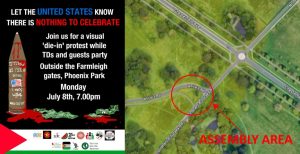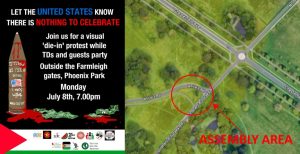Jamie Allinson – Socialist Review
Both those who call for intervention and those who condemn the revolution in Syria are wrong. Jamie Allinson argues that Syrians can liberate themselves
On 23 February the self-appointed "Friends of Syria" met in Tunis to demand, in the words of Barack Obama, that "the international community…send a clear message to President Assad that it is time for a transition". Given that this group includes the US, UK and France, who have never rallied anyone to demand Israel’s withdrawal from occupied Syrian territory, and Saudi Arabia, whose troops have enforced a bloody terror against the Bahraini revolution, Syrian activists might think that with friends like these they don’t need enemies. But where is the Syrian uprising to go, apparently trapped between a regime determined to bring the country down around it and imperialist projects to deflect the revolution?
The question of foreign intervention divides both the Syrian opposition and the left in the region and beyond. In the face of the regime’s brutal response to the uprising, which has seen 6,000 people killed and tens of thousands injured or imprisoned, some in the Syrian opposition and in besieged cities such as Homs have come to see foreign intervention as a shortcut to the ousting of Assad. The opposition is not homogeneous, however. There are three main organised elements to it: the Syrian National Council (SNC), the Local Coordinating Committees (LCC) and the "Free Syrian Army" (FSA).
Divided
Jamie Allinson – Socialist Review
Both those who call for intervention and those who condemn the revolution in Syria are wrong. Jamie Allinson argues that Syrians can liberate themselves
On 23 February the self-appointed "Friends of Syria" met in Tunis to demand, in the words of Barack Obama, that "the international community…send a clear message to President Assad that it is time for a transition". Given that this group includes the US, UK and France, who have never rallied anyone to demand Israel’s withdrawal from occupied Syrian territory, and Saudi Arabia, whose troops have enforced a bloody terror against the Bahraini revolution, Syrian activists might think that with friends like these they don’t need enemies. But where is the Syrian uprising to go, apparently trapped between a regime determined to bring the country down around it and imperialist projects to deflect the revolution?
The question of foreign intervention divides both the Syrian opposition and the left in the region and beyond. In the face of the regime’s brutal response to the uprising, which has seen 6,000 people killed and tens of thousands injured or imprisoned, some in the Syrian opposition and in besieged cities such as Homs have come to see foreign intervention as a shortcut to the ousting of Assad. The opposition is not homogeneous, however. There are three main organised elements to it: the Syrian National Council (SNC), the Local Coordinating Committees (LCC) and the "Free Syrian Army" (FSA).
Divided
The SNC has called most widely for foreign intervention and, like the Libyan Transitional National Council, has worked closely with the UK and France. It is internally divided, however, and is dominated by exiles such as Burhan Ghalioun, who has declared that a post-Assad Syria should cut ties with Iran and stop funding resistance movements such as Hamas and Hezbollah. The SNC has dedicated its main energies to winning support for intervention, not to protests on the ground.
The LCC’s comprise the actual networks of the uprising within Syria. It combines an older generation of activists with those who have sprung up since February 2011. The LCC reject any programme of foreign influence, but support the idea of an arms embargo, assets freeze and establishment of humanitarian aid corridors. These calls may grow as the situation in cities such as Homs becomes more desperate. However, the LCC’s have also been at the forefront of calls for a "dignity strike", or general strikes against the regime.
The FSA is the newest component of the revolution, but it should not be seen as one entity. Defecting officers, such as Riad Asa’ad, have tried to claim leadership of these "brigades", but there is no evidence of a centralised command. Rather the FSA refers to lightly armed guerrillas, based around army defectors or locally respected leaders, which initially functioned to protect demonstrations. Reports suggest these groups obtain money from expatriate Syrians and occasionally local businessmen, and buy their weapons locally. However, Saudi Arabia and Qatar have seen the potential for grooming the FSA groups and have called arming them an "excellent idea".
The regime maintains that the revolutionaries are armed Islamist gangs, serving a Zionist-US-Salafi-Qatari-Saudi-French conspiracy to dismember Syria. Hezbollah’s general secretary Hassan Nasrallah has shamefully repeated these claims. Anyone who believes this argument should name the last time Assad attacked Israeli forces with the ferocity with which his forces are pounding the workers, peasants and poor of Homs. Nonetheless, it is true that Western powers, Saudi Arabia, Qatar and Turkey see the revolution as an opportunity to extend their influence and get rid of an irritant regime.
"Friends of Syria"
The meeting of the so-called "Friends of Syria" was an attempt to bypass the UN security council, where two weeks previously Russia and China had vetoed a resolution calling for a "transition plan" in Syria backed by the Arab League. Following that rejection, a number of moves, including the "Friends of Syria Conference", the British recognition of the SNC as the "legitimate representative" of the Syrian people, and the freezing of Syrian assets by the European Central Bank, suggested the possibility of a Libyan-style campaign to finish Assad off.
Russia and China are also pursuing their own interests in backing Assad. Clinton’s description of their veto as "despicable" rings rather hollow when one remembers the innumerable US vetoes wielded to protect Israel, including one calling for an end to the 2009 assault on Gaza. Indeed, the Russian counter-draft adopted a longstanding Western tactic in relation to the Palestinians: spuriously blaming both the victims and the perpetrators of massacres. Russia will not give up on Syria, at least not until the regime’s demise is unstoppable. Assad represents the last redoubt of Russian influence in the region, and the port of Tartus holds Russia’s only naval base in the Mediterranean. Putin dispatched an aircraft carrier and task force to this base at the end of 2011 in an apparent show of support for the regime.
This geopolitical struggle has given rise to confusion on the left in the Middle East and beyond. Unlike in Libya, few prominent leftists have spoken in favour of Assad. More common, especially in the neighbouring countries of Syria and Jordan, has been the position that even if Assad’s is a tyrannical regime, it remains the only Arab friend of anti-imperialist resistance, and the only barrier to a collapse into sectarian civil war fomented by Saudi Arabia. There are sectarian elements in the opposition, but these have so far largely been restrained by the LCC’s vision of cross-sectarian unity. But the longer the regime persists, the more its divide and rule tactics, for example shelling Sunni districts of Homs while sparing Alawite ones, exacerbate the risk of sectarian implosion. Foreign intervention would increase rather than diminish the risk of such a disaster, as in Iraq.
Third alternative
Calls for intervention, and the responses to them that oppose imperialism by slandering the revolution are both wrong. What is the alternative, however? First it should be noted that, despite Assad’s savagery and the Russian-Chinese veto, the revolution seems to be spreading to areas (such as inner Damascus and Aleppo) and communities (such as the Druze) that have hitherto remained agnostic. In both Egypt and Tunisia the final blow to the dictator was dealt by the working class in the form of strike waves that coalesced into a general strike. In Syria such a strategy would have the advantage of both deflecting sectarianism and hitting at the power of the capitalists of Damascus and Aleppo who have, with some exceptions, remained wedded to the regime.
Is there any prospect of such an outcome? Syria has a larger working class and longer tradition of organisation than, for example, Libya, but the networks of resistance forged in the Egyptian strike wave of 2006-8 have no counterpart. However, the "dignity strike" called by the LCC’s in December 2011 seems to have had some success in spreading through Damascus, and was widely observed in Dera’a and Homs.
The strikes have not yet reached the level that can finally bring down the regime. To do so, they would probably have to unite political opposition to the regime with demands to alleviate increasing economic hardship of workers. The Syrian Revolution remains in the balance. Only the massive intervention of the country’s workers, not foreign invasion, can tip it the right way.






